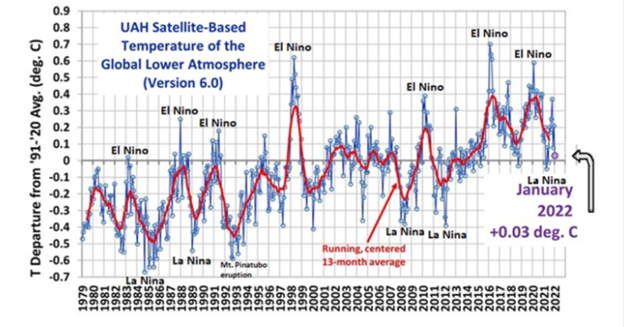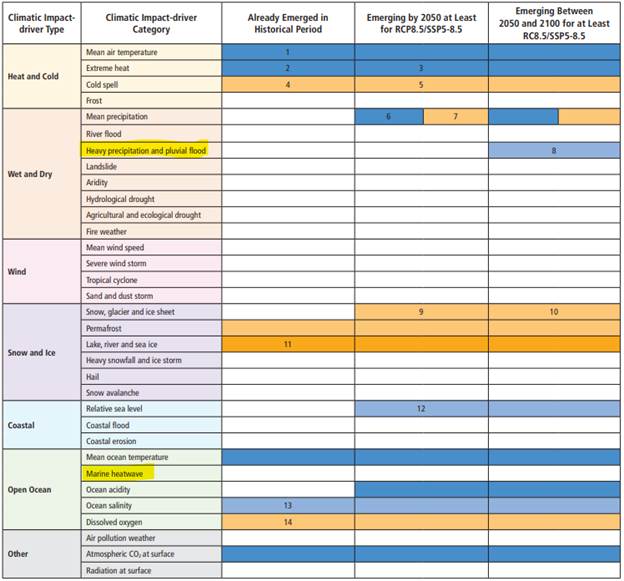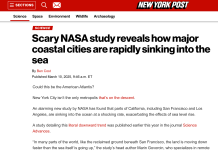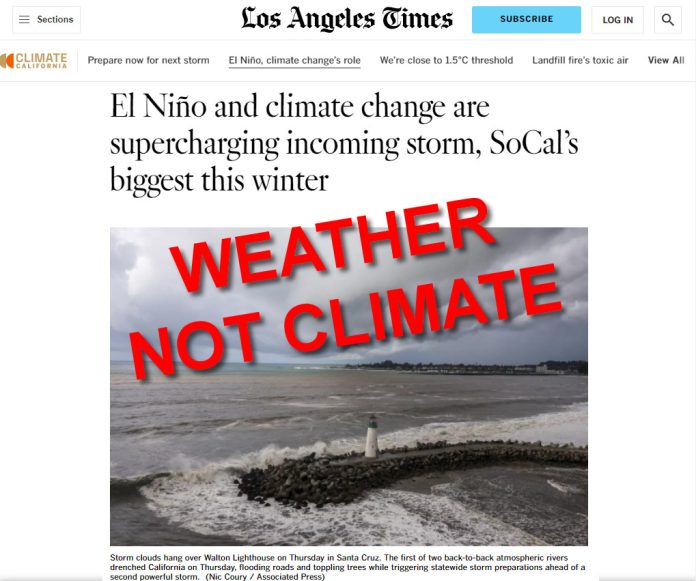An article in the Los Angeles Times (LAT) by Hayley Smith and Grace Toohey, titled “El Niño and climate change are supercharging incoming storm, SoCal’s biggest this winter,” falsely claims the present storm is being caused or exacerbated by climate change. While it is true the present storm will be the biggest storm so far in 2024, there is no evidence it is unique historically or driven by climate change. Smith and Toohey write:
But the powerful atmospheric river — worrisome enough on its own — is being supercharged by climate change and El Niño, which together are warming ocean waters, upping the odds of significant downpours and offering a preview of the state’s future in a warming world, experts say.
The incoming storm is feeding off unusually warm waters between California and Hawaii where a significant marine heat wave has persisted for months, said Daniel Swain, a climate scientist with UCLA.
As is typical for many media outlets these days, the authors of the LAT story are conflating short term weather patterns with long term climate change. As defined by the World Meteorological Organization, and referenced in Climate at a Glance: Weather vs. Climate, climate is an average of weather over 30 years. So, “a significant marine heat wave has persisted for months” is part of a short-term weather pattern, not an indication long-term climate change. For example, it is unlikely to be there next year. Only a long-term trend of increasing significant marine heat waves or marine heat waves of greater strength would suggest a signal of climate change, cut no such trend can be found in the record.
Further, while the current moderate El Niño might certainly have an effect on weather patterns, it too is a relatively short-term event. For example, last year there was a La Nina pattern and California saw record amounts of snowfall. Back then, the LAT claimed that “California drought, Australia floods: Two sides of La Niña amplified by climate change,” which was thoroughly debunked by my colleague Linnea Lueken in the ClimateRealism piece Los Angeles Times Ignores Science, Claims Climate Change is Amplifying La Niña. In that article, Lueken provided data showing that neither flooding or drought had increased in California.
According to the National Oceanic and Atmospheric Administration (NOAA): “El Niño is a naturally occurring climate pattern associated with warming of the ocean surface temperatures in the central and eastern tropical Pacific Ocean, which can significantly influence weather patterns, ocean conditions, and marine fisheries worldwide.” Furthermore, El Niño events in the Pacific Ocean are natural patterns that have been going on for millions of years.
The supposed human driven climate change has been noted for a century so you can’t really claim that El Niño or La Niña events spanning millennia are being driven by the recent noted warming, especially if they change from year to year from warm to cool.
The LAT quotes Daniel Swain, a climate scientist with UCLA, saying,
“As ocean temperatures warm, and as atmospheric temperatures warm, those rates of evaporation of water vapor into the lower atmosphere are going to increase quite quickly,” Swain said during a briefing Friday. “A few degrees of warming of nearshore and offshore water temperatures means that there’s more moisture in that lower atmosphere.”
In other words, extra heat and moisture from the warm sea surface are moistening the atmospheric river storms as they approach California, making them more likely to deliver heavy rainfall.
But that doesn’t explain how in the winter of 2022 and 2023, when California had a record snowfall year during a La Niña event, that extra evaporated moisture made it into the atmosphere when the ocean surface was cooler.
You can’t have it both ways when trying to blame climate change for weather events.
Because La Niña and El Niño cycles often span multiple consecutive years, the last La Niña event impacted the Pacific during the winter of 2020-2021 and then again in the winter of 2022/2023, as shown in this analysis (figure below) by Meteorologist Paul Dorian, “La Nina Conditions Continue Across the Equatorial Pacific.”

Then in June 2023 the pattern switched to El Niño, and now the LAT is flip-flopping the climate blame game for weather events, based mainly on opinion from one scientist.
The most damning evidence against the flip-flopping LAT claims comes from the latest climate report by the Intergovernmental Panel on Climate Change (IPCC). On table 12.12 on Page 90 – Chapter 12 of the IPCC Sixth Assessment Report. Emergence of Climate Impact Drivers (CIDs) seen below, there is no evidence in the present that climate change is affecting heavy precipitation or marine heat waves, highlighted in yellow.

As can be seen from the IPCC Table 1, there is no evidence of any increase or decrease, globally or by region, in the frequency, severity or extent of frost, mean precipitation, river floods, heavy precipitation and pluvial floods, landslides, aridity, hydrological drought, agricultural or ecological drought, fire weather or wildfires, mean wind speed, severe wind storms or tornados, tropical cyclones or hurricanes, sand and dust storms, snow glacial or ice sheets, heavy snowfall and ice storms, hail, snow avalanche, relative sea levels, coastal floods, coastal erosion, marine heatwaves, ocean acidity, or air pollution enhancing weather.
In other words, climate change isn’t driving current weather patterns at all.
There’s no evidence supporting the LAT claim that climate change enhancing El Niño in a way that would cause heavier precipitation during the present storm in California. Instead, what this story really reveals is just another couple of low-information journalists’ efforts to blame every negative weather event on human caused climate change.

















Totally predictable that LAT would come out with using El Niño and an atmospheric river system to shove climate change down our throats! Nonsensical but what do you expect from these propagandists Pravda newspapers and media outlets! They never substantiate anything other empty rhetoric! If they ever show data it’s skewed or slanted towards an outlier as the normal comparison! I quit buying these worthless rags decades ago with their biased opinions and misinformation! Waste if a tree!